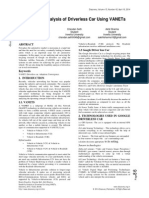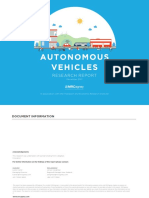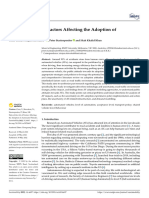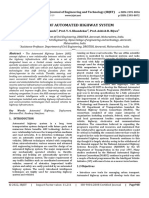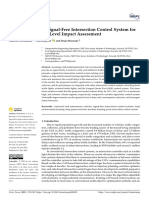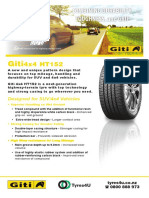Autonomous Vehicles CSS16-18
Autonomous Vehicles CSS16-18
Uploaded by
sheejadileep8289Copyright:
Available Formats
Autonomous Vehicles CSS16-18
Autonomous Vehicles CSS16-18
Uploaded by
sheejadileep8289Copyright
Available Formats
Share this document
Did you find this document useful?
Is this content inappropriate?
Copyright:
Available Formats
Autonomous Vehicles CSS16-18
Autonomous Vehicles CSS16-18
Uploaded by
sheejadileep8289Copyright:
Available Formats
Mobility
Autonomous Vehicles Autonomous Vehicle Technologies1,7,8,9
Autonomous vehicles (AVs) use technology to partially or entirely
replace the human driver in navigating a vehicle while avoiding
road hazards and responding to traffic conditions.1 The Society
of Automotive Engineers (SAE) has developed, and the U.S.
National Highway Traffic Safety Administration (NHTSA) uses, a
classification system with six levels based on the level of human
intervention.2
SAE Levels of Automation2,3
Current and Projected Market
Key Market Leaders
• In 2021, North America was preceived to be leading the AV
race ahead of China. In 2023, this perception was evenly split,
according to a McKinsey survey.10
• Waymo has tested its vehicles by driving over 20M miles on
roads and tens of billions of miles in simulation.11 Teslas have
driven over 3B miles in Autopilot mode since 2014.12
• Other major players include Audi, BMW, Daimler, GM, Nissan,
Volvo, Bosch, Continental, Mobileye, Valeo, Velodyne,
Nvidia, Ford, as well as many other OEMs and technology
companies.6,13
Regulations, Liability, and Projected Timeline
Development of Autonomous Vehicles • Regulation will impact the adoption of AVs.14 In the U.S. there
are no national standards or guidelines for AVs, allowing
AV research started in the 1980s when universities began
states to determine their own.14 In 2018, Congress worked
working on two types of AVs: one that required roadway infra-
to pass the AV Start Act that would have implemented a
structure and one that did not.1 The U.S. Defense Advanced
framework for the testing, regulating, and deploying of AVs.
Research Projects Agency (DARPA) has held “grand challenges”
The legislation failed to pass both houses.15 As of February
testing the performance of AVs on a 150-mi off-road course.1
2020, 29 states and D.C. have enacted legislation regarding
No vehicles successfully finished the 2004 Grand Challenge, but
the definition of AVs, their use, and liability.16
five completed the course in 2005.1 In 2007, six teams finished
the third challenge, which consisted of a 60-mi course navigating • Product liability laws need to assign liability properly when
an urban environment obeying normal traffic laws.1 In 2015, the AV crashes occur, as highlighted by the May 2016 Tesla Model
University of Michigan built Mcity, the first facility built for testing S fatality. Liability will depend on multiple factors, especially
AVs. Research is conducted there on the safety, efficiency, ac- whether the vehicle was being operated appropriately to its
cessibility, and commercial viability of AVs.4 Unmanned aircraft level of automation.17,18
systems (UAS), or drones, are being deployed for commercial • Although researchers, OEMs, and industry experts have
ventures such as last-mile package delivery, medical supply different projected timelines for AV market penetration
transportation, and inspection of critical infrastructure.5 and full adoption, the majority predict Level 5 AVs around
Autonomous Vehicle Technologies 2030.19,20
AVs use combinations of technologies and sensors to sense the
roadway, other vehicles, and objects on and along the roadway.6
• Travel Cost Reduction, due to decreased insurance cost and
Current Limitations and Barriers improvements in productivity and driving comfort, could
• There are several limitations and barriers that could result in increased travel, potentially increasing energy
impede adoption of AVs, including lack of buyer demand, consumption 4% to 60%.21
data security, protection against cyberattacks, regulations
• New User Groups are likely to increase VMT and fuel
compatible with driverless operation, resolved liability laws,
consumption by 2-10%.21
societal attitude and behavior change regarding distrust and
subsequent resistance to AV use, and the development of • Changed Mobility Services, such as an increase in ride-sharing
economically viable AV technologies.6 could reduce energy consumption 0-20%.21,26
• Weather can adversely affect sensor performance on AVs, Although an accurate assessment of these interconnected
potentially impeding adoption. Ford recognized this barrier impacts cannot currently be made, one study evaluated
and started conducting AV testing in the snow in 2016 at the potential impacts of four scenarios, each with unknown
Mcity, utilizing technologies suited for poor weather.13 likelihoods. The most optimistic scenario projected a 40%
decrease in road transport energy and the most pessimistic
Impacts and Solutions scenario projected a 105% increase in road transport energy.21
• Although AVs alone are unlikely to have significant direct Projected Fuel Consumption Impact Ranges21,25
impacts on energy consumption and GHG emissions,
if effectively paired with other technologies and new
transportation models, significant indirect and synergistic
effects on economics, the environment, and society are
possible.21,22
• One study found that when eco-driving, platooning,
intersection connectivity and faster highway speeds are
considered as direct effects of AVs, energy use and GHG
emissions can be reduced by 9%.23
Metrics and Associated Impacts
• Congestion is predicted to decrease, reducing fuel
consumption by 0-4%. However, decreased congestion is
likely to lead to increased vehicle-miles traveled (VMT),
partially offsetting the fuel consumption benefit.21 Potential Benefits and Costs
• Eco-Driving , a set of practices that reduce fuel consumption, • 42,795 people died in vehicle crashes in 2022.27 94% of
is predicted to reduce energy consumption by up to 20%.21 crashes are due to human error. AVs have the potential to
However, if AV algorithms do not prioritize efficiency, fuel remove/reduce human error and decrease deaths.28
efficiency may actually decrease.24
• AVs have the potential to reduce crashes by 90%, potentially
• Performance, such as fast acceleration, is likely to become saving approximately $190B per year.29
de-emphasized when comfort and productivity become travel
• The U.S. AV market is expected to grow to over $75B in 2030,
priorities, potentially leading to a 5-23% reduction in fuel
representing an increase of 350% from 2023.30
consumption.21
• The last-mile AV energy savings for public transportation were
• Improved Crash Avoidance, due to the increased safety
over 33% when compared to private vehicles.31
features of AVs, may allow for the reduction of vehicle weight
and size, decreasing fuel consumption 5-23%.21 • Potential benefits include: improvements in safety and
public health, increased productivity, quality of life, mobility,
• Vehicle Right-Sizing , the ability to match the utility of a
accessibility, and travel, especially for the disabled and
vehicle to a given need, has the potential to decrease energy
elderly; reduction of energy use, environmental impacts,
consumption 21-45%, though the full benefits are only likely
congestion, and public and private costs associated with
when paired with a ride-sharing on-demand model.21
transportation; and increased adoption of car sharing.1,14,32,33
• Higher Highway Speeds are likely due to improved safety,
• Potential costs include increased congestion, VMT, urban
increasing fuel consumption 7-30%.21,25
sprawl, total time spent traveling, and upfront costs of private
car ownership leading to social equity issues; impacts on
other modes of transportation; and increased concern with
security, safety, and public health.1,14,25,33,34
Cite as: Center for Sustainable Systems, University of Michigan. 2024. “Autonomous Vehicles Factsheet.” Pub. No. CSS16-18. October 2024
Sources for this factsheet are here, help with units and abbreviations is here.
You might also like
- CTM114619 - 121 ManualDocument2,423 pagesCTM114619 - 121 Manualalexanderhoffman100% (2)
- Truck Hacking: An Experimental Analysis of The SAE J1939 StandardDocument10 pagesTruck Hacking: An Experimental Analysis of The SAE J1939 StandardhomayounNo ratings yet
- 2013-02!06!164424 International TruckschematicsDocument98 pages2013-02!06!164424 International TruckschematicsLuciano Luiz Vadallares100% (1)
- Will Autonomy Usher in The Future of Truck Freight TransportationDocument8 pagesWill Autonomy Usher in The Future of Truck Freight TransportationkutaykizilkayaNo ratings yet
- Autonomous Vehicles - CSS16-18Document2 pagesAutonomous Vehicles - CSS16-18manandobusisekaNo ratings yet
- Autonomous Vehicles - CSS16-18 - E2020Document2 pagesAutonomous Vehicles - CSS16-18 - E2020Theju PaulNo ratings yet
- 1 s2.0 S0965856415000804 MainDocument15 pages1 s2.0 S0965856415000804 MainAnkit SinghNo ratings yet
- Preparing A Nation For Autonomous Vehicles: Opportunities, Barriers and Policy Recommendations For Capitalizing On Self-Driven VehiclesDocument20 pagesPreparing A Nation For Autonomous Vehicles: Opportunities, Barriers and Policy Recommendations For Capitalizing On Self-Driven VehiclesJose Antonio GarciaNo ratings yet
- Feasibility Analysis of Driverless Car Using Vanets: 1.2 Google Driver Less CarDocument3 pagesFeasibility Analysis of Driverless Car Using Vanets: 1.2 Google Driver Less CarhrishikeshNo ratings yet
- Public Acceptance and Perception of Autonomous Vehicles A Comprehensive ReviewDocument33 pagesPublic Acceptance and Perception of Autonomous Vehicles A Comprehensive ReviewbaspehlivancansuNo ratings yet
- Robert ParkerDocument21 pagesRobert Parkerjohanessantosa830No ratings yet
- AASHTO Footprint AnalysisDocument6 pagesAASHTO Footprint Analysisjulio cesarNo ratings yet
- Background On Autonomous and Connected VehcilesDocument4 pagesBackground On Autonomous and Connected VehcilesUsman FarooqNo ratings yet
- Dc-656837-V1-Torts of The Future Autonomous EmailableDocument20 pagesDc-656837-V1-Torts of The Future Autonomous EmailablejulianNo ratings yet
- MRCagney Autonomous Vehicles Research PaperDocument43 pagesMRCagney Autonomous Vehicles Research PaperBen RossNo ratings yet
- Glaser, Se-BastienDocument24 pagesGlaser, Se-BastienSafae BelkhyrNo ratings yet
- Sustainability 14 06697 v2Document29 pagesSustainability 14 06697 v2Hafsa FarrukhNo ratings yet
- Autonomous VehiclesDocument61 pagesAutonomous VehiclesRohan RahalkarNo ratings yet
- Driverless CarsDocument41 pagesDriverless CarsYaner LimNo ratings yet
- H ARSWARE3Document7 pagesH ARSWARE3rajuNo ratings yet
- WEF SafeDI Creating Safe AV Policy 2020Document21 pagesWEF SafeDI Creating Safe AV Policy 2020MariusNo ratings yet
- No Driver No RegulationDocument3 pagesNo Driver No RegulationjoiceNo ratings yet
- Autonomous VehiclesDocument16 pagesAutonomous VehiclesmarcopisaNo ratings yet
- The Future of Autonomous Vehicles - Revolutionizing TransportationDocument3 pagesThe Future of Autonomous Vehicles - Revolutionizing Transportationtsb56625No ratings yet
- A Systematic Literature Review of The Factors Influencing The Adoption of Autonomous DrivingDocument18 pagesA Systematic Literature Review of The Factors Influencing The Adoption of Autonomous Drivingvinoham666No ratings yet
- Autonomous, Connected, Electric and Shared VehiclesDocument52 pagesAutonomous, Connected, Electric and Shared VehiclesAmatek Teekay 特克纳No ratings yet
- Full Paper Guerson and Haichert ICWIM Australia - FinalDocument9 pagesFull Paper Guerson and Haichert ICWIM Australia - FinalLeonardoPerimGuersonNo ratings yet
- Collision Risk in Autonomous Vehicles Classification Challenges and Open Research AreasDocument34 pagesCollision Risk in Autonomous Vehicles Classification Challenges and Open Research Areasbardia.hszdNo ratings yet
- WP Testing v2x SystemsDocument12 pagesWP Testing v2x Systemslalshawalaaa.ec21No ratings yet
- A Survey of Deep Learning Applications To Autonomous Vehicle ControlDocument23 pagesA Survey of Deep Learning Applications To Autonomous Vehicle ControltilahunNo ratings yet
- AvipDocument23 pagesAvipAnonymous 0RxchcrqBNo ratings yet
- Presentation FinalDocument10 pagesPresentation Finalavini.progenNo ratings yet
- GTPDocument4 pagesGTPjonatanskulpe2021No ratings yet
- Autonomous VehiclesDocument61 pagesAutonomous VehiclesSatkar AgrawalNo ratings yet
- Study of Automated Highway System: International Research Journal of Engineering and Technology (IRJET)Document11 pagesStudy of Automated Highway System: International Research Journal of Engineering and Technology (IRJET)Sumit bagadeNo ratings yet
- Development of A Signal-Free Intersection Control System For CAVs and Corridor Level Impact AssessmentDocument16 pagesDevelopment of A Signal-Free Intersection Control System For CAVs and Corridor Level Impact AssessmentChristian Kyle BeltranNo ratings yet
- Autonomous, Connected, Electric and Shared Vehicles: Reimagining Transport To Drive Economic GrowthDocument52 pagesAutonomous, Connected, Electric and Shared Vehicles: Reimagining Transport To Drive Economic GrowthMwaisa BangaNo ratings yet
- All Blocks for AvDocument8 pagesAll Blocks for Avethan.gao28No ratings yet
- 2013 Iv SRXDocument8 pages2013 Iv SRXSai Krishna KARANAMNo ratings yet
- Autonomous Vehicles Report 2020 PDFDocument92 pagesAutonomous Vehicles Report 2020 PDFMayara CarneiroNo ratings yet
- Autonomous Vehicles FINALDocument27 pagesAutonomous Vehicles FINALthanNo ratings yet
- Automated HIGhway SYStem CPP ProjectDocument88 pagesAutomated HIGhway SYStem CPP ProjectDurvank ShethNo ratings yet
- Machines 11 00676 v3Document29 pagesMachines 11 00676 v3javokhirrakhimov99No ratings yet
- BCG Mapping The Future of Autonomous Trucking Oct 2022Document16 pagesBCG Mapping The Future of Autonomous Trucking Oct 2022rachel.carol17No ratings yet
- Transportation Research Part C: Chana J. Haboucha, Robert Ishaq, Yoram ShiftanDocument13 pagesTransportation Research Part C: Chana J. Haboucha, Robert Ishaq, Yoram ShiftanZAIN AHMEDNo ratings yet
- Effects of Innovation in Automated Vehicles On Occupant Compartment Designs, Evaluation, and Safety: A Review of Public Marketing, Literature, and StandardsDocument11 pagesEffects of Innovation in Automated Vehicles On Occupant Compartment Designs, Evaluation, and Safety: A Review of Public Marketing, Literature, and StandardsJacob FisherNo ratings yet
- Future ImpDocument23 pagesFuture Impitsasif14950No ratings yet
- A Survey of Autonomous Driving, Common Practices and Emerging TechnologiesDocument27 pagesA Survey of Autonomous Driving, Common Practices and Emerging TechnologiesFang YuanNo ratings yet
- VA Todd LitmanDocument23 pagesVA Todd LitmanSamuel MatiasNo ratings yet
- A Survey of Motion Planning and Control Techniques For Self-Driving Urban VehiclesDocument23 pagesA Survey of Motion Planning and Control Techniques For Self-Driving Urban VehiclesNavneet YadavNo ratings yet
- Lane Line Detection - Self Driving Cars: Presented By: Group 3Document15 pagesLane Line Detection - Self Driving Cars: Presented By: Group 3Lovepreet SahotaNo ratings yet
- The Future of V2V, Draft 3, RevisedDocument4 pagesThe Future of V2V, Draft 3, Revisedxihe.mailboxNo ratings yet
- Autonomy Burns en 37711Document7 pagesAutonomy Burns en 37711gokcenNo ratings yet
- MachineLearningAlgorithmsforPredictiveMaintenanceinAutonomousVehiclesDocument18 pagesMachineLearningAlgorithmsforPredictiveMaintenanceinAutonomousVehicleslt3871568No ratings yet
- Quectel Connected Car White PaperDocument11 pagesQuectel Connected Car White Papermuskan beeNo ratings yet
- Software Verification and Validation of Safe Autonomous Cars - A Systematic Literature ReviewDocument23 pagesSoftware Verification and Validation of Safe Autonomous Cars - A Systematic Literature ReviewBill HoNo ratings yet
- PPWP24-How Insurers Are Putting-V1Document4 pagesPPWP24-How Insurers Are Putting-V1metineeklaNo ratings yet
- 05 - Autonomous VehiclesDocument6 pages05 - Autonomous VehiclesBill PetrieNo ratings yet
- Accenture Insight Mobility IoT Autonomous Vehicles PDFDocument12 pagesAccenture Insight Mobility IoT Autonomous Vehicles PDFDivya GiriNo ratings yet
- 2023 Advocates ReportDocument5 pages2023 Advocates Reportr.willingNo ratings yet
- Vehicle Infrastructure Integration: Unlocking Insights and Advancements through Computer VisionFrom EverandVehicle Infrastructure Integration: Unlocking Insights and Advancements through Computer VisionNo ratings yet
- Safety and Intelligent Transport Systems Development in the People’s Republic of ChinaFrom EverandSafety and Intelligent Transport Systems Development in the People’s Republic of ChinaNo ratings yet
- 1 LHDDocument1 page1 LHDManuel De Jesus Fuentes OrtizNo ratings yet
- Vechile Price DetailsDocument1 pageVechile Price Detailsvikky.tphNo ratings yet
- CHAPTER-3 Suspension SystemDocument159 pagesCHAPTER-3 Suspension SystemEssa YimerNo ratings yet
- Cars e PDFDocument73 pagesCars e PDFBGNo ratings yet
- GOMA Giti 4x4 HT152Document2 pagesGOMA Giti 4x4 HT152Leandro JorgeNo ratings yet
- RavindraDocument3 pagesRavindraPriyanshu ChauhanNo ratings yet
- Sensores DetonacionDocument40 pagesSensores DetonaciontornomanNo ratings yet
- WE3B0018101 Three Wheel PalmDocument70 pagesWE3B0018101 Three Wheel PalmPrita ShofiNo ratings yet
- Arado Ar-E381Document4 pagesArado Ar-E38118912170No ratings yet
- Raba Diff ManualDocument44 pagesRaba Diff ManualMorries100% (1)
- Volkswagen Chronik 1904 1936Document3 pagesVolkswagen Chronik 1904 1936WillianSilvaNo ratings yet
- Traffic PrintDocument21 pagesTraffic PrintChristopher PjunatasNo ratings yet
- Dakar Rally 2021Document11 pagesDakar Rally 2021Putu RustikaNo ratings yet
- Mercruiser Pistons & RingsDocument4 pagesMercruiser Pistons & RingsJSMarine Parts ChinaNo ratings yet
- KVS Format of Reimbursement DA Food Bill Travel and HotelDocument3 pagesKVS Format of Reimbursement DA Food Bill Travel and HotelLokeshNo ratings yet
- Landing TechniquesDocument26 pagesLanding TechniquesKaroon Sem100% (1)
- Q300 enDocument2 pagesQ300 enhenry_aero100% (2)
- Other Auto AppzDocument169 pagesOther Auto AppzGiapy Phuc TranNo ratings yet
- Owners - Manual Smart PassionDocument226 pagesOwners - Manual Smart PassionBernardo RamirezNo ratings yet
- YS 61ST - 2 enDocument2 pagesYS 61ST - 2 enknockcontrolNo ratings yet
- Component Transmission Outputs Monitor SummaryDocument3 pagesComponent Transmission Outputs Monitor SummaryfrankNo ratings yet
- Work Sheet2 - Mangelhafte Ware: Task 1: Thema GewährleistungDocument2 pagesWork Sheet2 - Mangelhafte Ware: Task 1: Thema GewährleistungLuca R.No ratings yet
- DEUTZ FL912 & FL913 Series Diesel Engine For Generator Set Application - FD Power CoDocument2 pagesDEUTZ FL912 & FL913 Series Diesel Engine For Generator Set Application - FD Power CoAshraf m ali100% (1)
- World English Intro Module 2 Jobs around the WorldDocument57 pagesWorld English Intro Module 2 Jobs around the WorldEric FernandezNo ratings yet
- Alfa 159 - Alfa 159 Sportwagon Alfa 159 - Alfa 159 SportwagonDocument25 pagesAlfa 159 - Alfa 159 Sportwagon Alfa 159 - Alfa 159 SportwagonMatei L. MarianNo ratings yet
- Facts and Figures - Porsche Taycan TurboDocument1 pageFacts and Figures - Porsche Taycan TurbowattafillingNo ratings yet
- Brosur Cummins 2018Document2 pagesBrosur Cummins 2018Pujangga Tanpa NamaNo ratings yet
- Catalogo Filtros Coreanos - JHF QDDocument7 pagesCatalogo Filtros Coreanos - JHF QDGabriel Escarcena RoblesNo ratings yet








